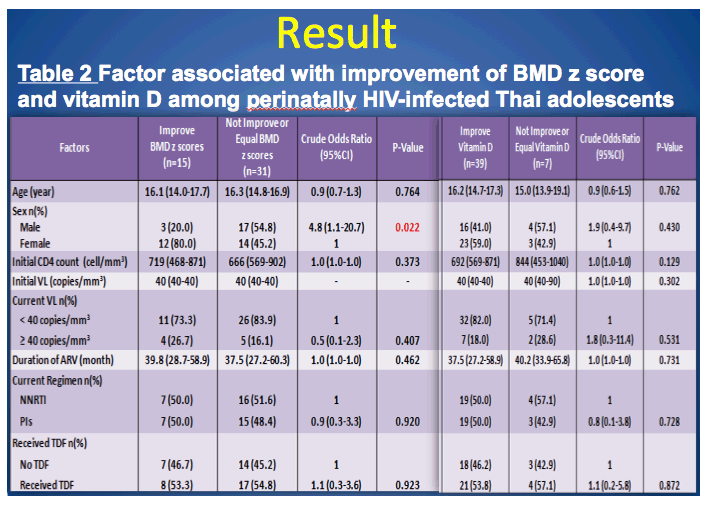 |
 |
 |
| |
Longitudinal study of bone mineral density and vitamin D levels among perinatally HIV-infected Thai adolescents receiving long-term antiretroviral therapy
|
| |
| |
Reported by Jules Levin
IAS 2013 Kuala Lumpur June 30-July 3
Surapong Tanchaweng, MD a Thanyawee Puthanakit, MD b,c, Rachanee Saksawad, MD a, Chantapat Brukesawan MD a, Alan Maleesatharn, MBAa, Kulkanya Chokephaibulkit, MD a,*
a Department of Pediatrics, Faculty of Medicine Siriraj Hospital, Mahidol University, Bangkok, Thailand, 10700.
b Department of Pediatrics, Faculty of Medicine, Chulalongkorn University, Bangkok, Thailand 10330.
c HIV-NAT/Thai Red Cross AIDS Research, 104 Ratchadamri Road, Pathumwan, Bangkok Thailand 10330.
Program Abstract
Background: : High prevalence of low bone mineral density (BMD) has been observed in HIV-infected adolescents. We explored the changes in BMD and vitamin D during adolescence in a cohort of perinatally HIV-infected adolescents.
Methods: Lumbar spine (L2-L4) BMD measured by dual-energy X-ray absorptiometry (DXA) scans and blood tests for 25-hydroxyvitamin D (25-OHD) were performed in adolescents receiving care at Siriraj Hospital, Bangkok, Thailand, at two time points, 12-24 months apart. All adolescents received counseling and education on lifestyle and food choices to promote bone health. None received calcium or vitamin D supplements between the two BMD measurements.
Results: Of the 47 adolescents enrolled, 44.7% were male, and median age (range) at the first and the second measurements were 14.5 (12.0-18.3) and 16.2 (13.2-20) years, respectively. At the first measurement, the median (range) BMD z-score was -1.16 (-3.8 to 1.9). The proportion of adolescents with BMD z-scores ≤ -1.5, ≤ -2.0, and ≤ -2.5 were 17.0%, 12.8% and 10.6%, respectively; 13(27.7%) had 25-OHD levels < 20 ng/ml. At the second measurement, the median (range) BMD z-score fell to -1.41 (-4.75 to 2.3; p=0.023). The proportion of adolescents with BMD z-scores ≤-1.5, ≤-2.0, and ≤-2.5 were 27.7%, 10.6% and 8.5%, respectively; 2 (4.3%) had 25-OHD levels < 20 ng/ml (p< 0.000).
Conclusion: Perinatally HIV-infected Thai adolescents have high rates of low BMD and vitamin D deficiency. Educational counseling seemed to help improve vitamin D levels, but BMD levels continued to decrease during adolescence. Detection and prevention of osteopenia should be incorporated in routine care for adolescents.





|
| |
|
 |
 |
|
|